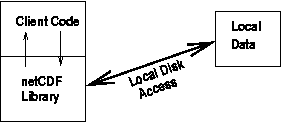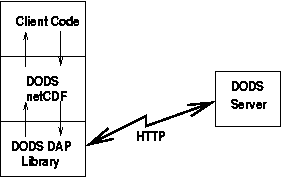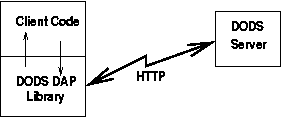ProgrammerGuideChapter7: Difference between revisions
(New page: =Overview of the OPeNDAP Client= A OPeNDAP client is any web client that makes a service request to a OPeNDAP server. Since several of the OPeNDAP services return ASCII and HTML data, a...) |
|||
| Line 15: | Line 15: | ||
library. | library. | ||
<center> | |||
[[Image:orig-client.gif|actual size]] | |||
The Original Program | |||
</center> | |||
The Original Program, untouched by | The Original Program, untouched by | ||
| Line 23: | Line 31: | ||
data. | data. | ||
<center> | |||
[[Image:client-arch1.gif|actual size]] | |||
The Modified Program | |||
</center> | |||
The Modified Program, using the | The Modified Program, using the | ||
| Line 37: | Line 50: | ||
HTTP GET requests to a OPeNDAP server. The client code is unchanged. | HTTP GET requests to a OPeNDAP server. The client code is unchanged. | ||
<center> | |||
[[Image:client-arch2.gif|actual size]] | |||
The Another Way | |||
</center> | |||
Another Way. An application program can | Another Way. An application program can also call the OPeNDAP DAP directly, eliminating the need for a client library. When starting from scratch, this is probably easiest, unless you are an old hand at one of the supported data access APIs. | ||
also call the OPeNDAP DAP directly, eliminating the need for a client | |||
library. When starting from scratch, this is probably easiest, | |||
unless you are an old hand at one of the supported data access APIs. | |||
Latest revision as of 14:11, 26 January 2008
Overview of the OPeNDAP Client
A OPeNDAP client is any web client that makes a service request to a OPeNDAP server. Since several of the OPeNDAP services return ASCII and HTML data, any web browser, such as Netscape Navigator can be considered a OPeNDAP client, so long as it is in the process of making a suitable request to a OPeNDAP server. The clients of interest in this appendix, however, are clients that use the OPeNDAP DAP (Data Access Protocol) library to make their requests for data.
Of these clients, there are two varieties: clients that have been written expressly for OPeNDAP, and clients that existed in some form already, and that have been adapted to use with a OPeNDAP client library.
The Original Program
The Original Program, untouched by OPeNDAP. The application's code accesses data by calls to the netCDF library functions, linked with the program. Data access is direct, with the application program accessing local disk files to read data.
The Modified Program
The Modified Program, using the OPeNDAP netCDF client library. The application's code now accesses data by calls to the OPeNDAP netCDF library functions. These are written to be functionally identical to the original netCDF functions, but instead of using a local disk to retrieve data, this library invokes functions from the OPeNDAP DAP library, which makes HTTP GET requests to a OPeNDAP server. The client code is unchanged.
The Another Way
Another Way. An application program can also call the OPeNDAP DAP directly, eliminating the need for a client library. When starting from scratch, this is probably easiest, unless you are an old hand at one of the supported data access APIs.


